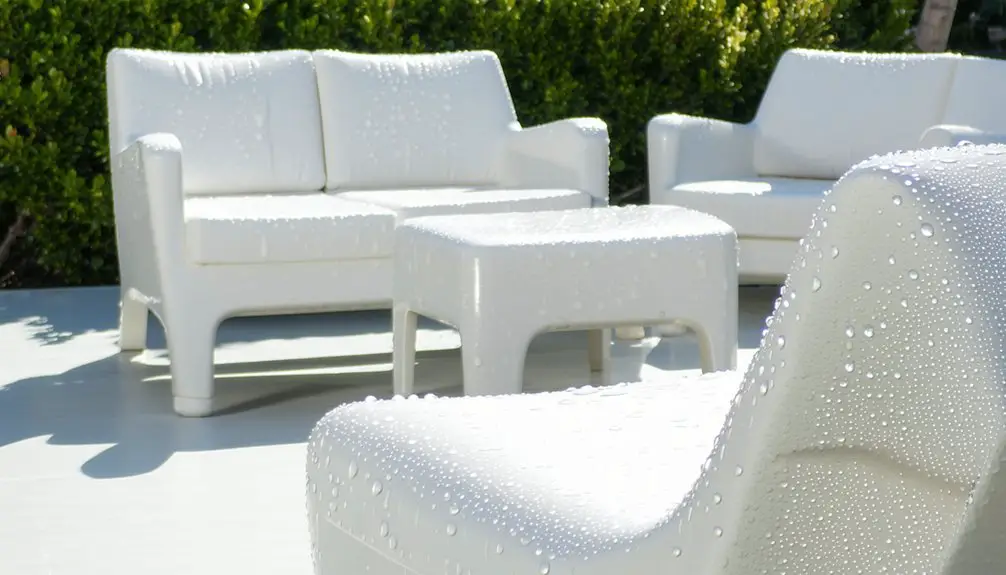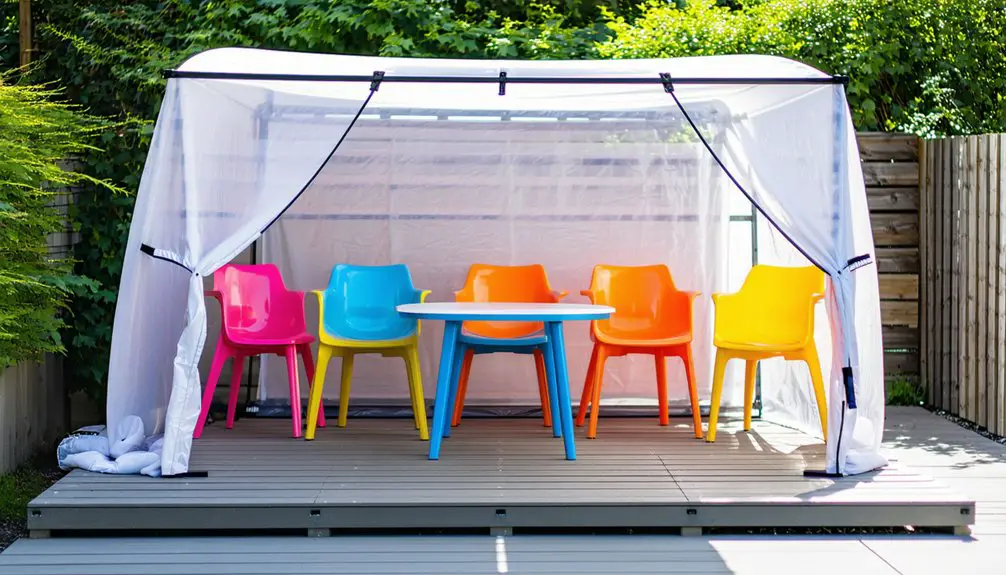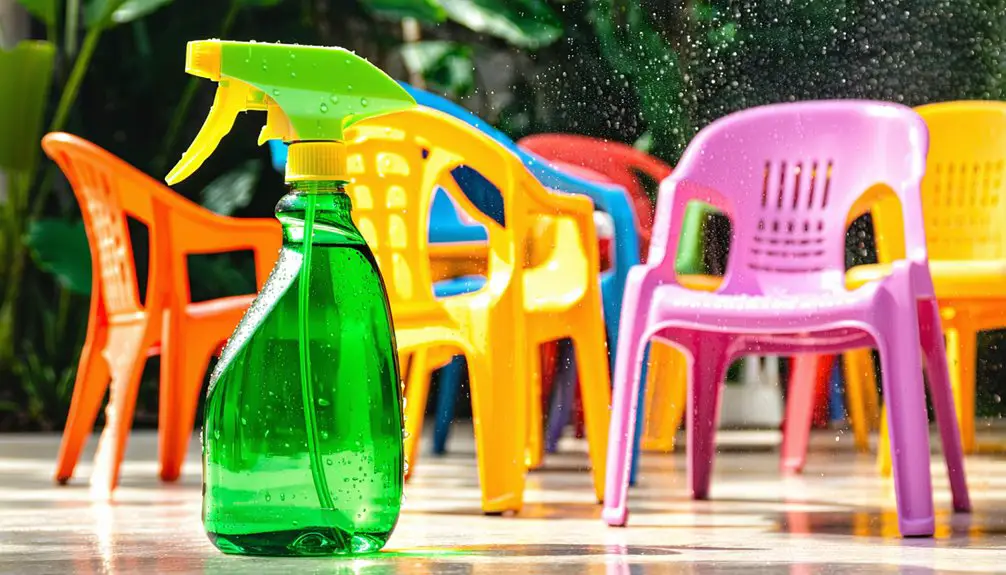To prevent mold and mildew on your plastic furniture, prioritize moisture-resistant materials like high-density polyethylene or polypropylene. Regularly clean your furniture using a mild vinegar solution or a bleach mix for tougher spots, and always scrub affected areas with a soft brush. Ensure you dry furniture in well-ventilated spaces and use mold-resistant covers when not in use. When storing, keep items in dry areas, elevate them for airflow, and consider breathable fabric covers. Following these tips can maintain the appearance and longevity of your furniture while keeping mold at bay—read on to discover more effective strategies.
Key Takeaways
- Choose moisture-resistant materials like HDPE or polypropylene for outdoor plastic furniture to prevent mold growth.
- Implement a regular cleaning routine using vinegar or mild soap to maintain a clean surface.
- Apply mold-resistant finishes to create a protective barrier against mold and mildew.
- Store furniture in a dry, well-ventilated area, using breathable covers to avoid moisture buildup.
- Regularly inspect furniture for signs of mold or mildew and address issues immediately to prevent spread.
Material Selection Strategies
When choosing materials for outdoor plastic furniture, you should prioritize options that resist moisture and fungal growth. Use UV protectors to prevent damage from sunlight, which can help extend the lifespan of your furniture.
Recycled plastic, particularly high-density polyethylene (HDPE), is an excellent choice because it's impermeable to water, effectively resisting mold, mildew, and fungi. Additionally, the strength-to-density ratio of HDPE contributes to its durability, ensuring that the furniture can withstand various outdoor conditions without compromising its integrity.
If you're considering chairs or other furniture, polypropylene stands out for its moisture resistance and ease of cleaning. It won't absorb water, which helps prevent warping and mold growth.
For added protection, look for materials with UV-resistant coatings. These coatings keep the surface dry, making it less inviting for fungi.
Fabrics like polyester, nylon, or vinyl are also effective for outdoor furniture covers; they naturally resist mold and mildew. You might also consider acrylic or olefin, as they possess water-resistant properties that help prevent mildew formation.
When selecting materials, ensure they're durable enough to withstand pressure and impact, which is crucial for outdoor furniture longevity.
Incorporating mold-resistant finishes and selecting smooth surfaces can further minimize moisture accumulation.
Effective Cleaning Techniques
To keep your plastic furniture looking its best and free from mold and mildew, it's essential to clean it regularly with effective solutions. Start by preparing a vinegar solution—mix equal parts white vinegar and water in a spray bottle. For a stronger option, combine a gallon of water with half a cup of bleach, but avoid this on cushions or wooden pieces. You might also try a lemon salt solution by mixing salt with lemon juice for an organic approach.
Before applying your chosen solution, brush the furniture and vacuum the area to remove loose debris. Spray the solution generously on mildew-affected areas and let it sit for 10-15 minutes. Mildew often appears as grey or white fluffy spots on damp surfaces, indicating areas that may need extra attention.
Use a soft-bristle brush or sponge to scrub in circular motions, ensuring you're gentle to avoid scratches. After scrubbing, rinse with hot water to eliminate any residue and mildew. Allow the furniture to air dry completely before using it again.
If stubborn mildew remains, repeat the process. Remember to wear a mask while cleaning to avoid inhaling mold spores. Regular maintenance will keep your furniture looking great and free from mold.
Benefits of Mold-Resistant Finishes

Mold-resistant finishes offer significant advantages for your plastic furniture, especially in damp or humid environments. These finishes contain additives that inhibit the growth of mold, mildew, and fungi, creating a protective barrier on the surface. This barrier prevents mold spores from attaching and reduces the risk of mold-related damage, keeping your furniture looking great and lasting longer.
In addition to preventing mold growth, these finishes improve durability and longevity. Treatments like UV-inhibiting stabilizers help prevent fading and discoloration from sunlight, ensuring your furniture remains vibrant. The durable and flexible coatings minimize the need for frequent repainting, enhancing the overall lifespan of your furniture with minimal maintenance. Additionally, using HDPE plastic sheets for outdoor furniture construction can further enhance the durability and resistance to mold and mildew.
Moreover, mold-resistant finishes contribute to enhanced indoor and outdoor air quality. By inhibiting the release of mold spores into the air, they create a healthier living environment, which is particularly beneficial for individuals with respiratory conditions or allergies.
While the initial investment might be higher, the long-term cost savings on repairs and maintenance make it a cost-effective choice. With quick drying times and various finishes available, you can easily apply them and enjoy your beautiful, mold-free furniture.
Environmental Maintenance Tips
Protecting your plastic furniture from mold and mildew involves more than just applying mold-resistant finishes; it also requires a solid environmental maintenance strategy.
Start by choosing plastic furniture made from mold-resistant materials, ensuring it's specifically designed for outdoor use. Look for UV-resistant coatings and water-resistant properties to prevent sun damage and moisture accumulation. Implementing a comprehensive mold prevention strategy is essential for long-term protection against fungi.
Establish a consistent cleaning routine. Regularly wash your furniture with warm water and mild soap, and use bleach when necessary, following the manufacturer's instructions.
After cleaning, dry your furniture in a well-ventilated area, steering clear of harsh chemicals that may harm the plastic.
Pay attention to environmental conditions. Position your furniture away from direct sunlight and heating vents to maintain stable temperatures.
Ensure good ventilation around your furniture to reduce humidity, and avoid placing it in high-moisture areas.
For better airflow, place your furniture on elevated surfaces and avoid stacking items on top.
Utilize mold-resistant covers when not in use, and regularly inspect your furniture for any signs of mold or mildew.
Optimal Storage Practices

Storing your plastic furniture correctly can significantly extend its lifespan and prevent mold and mildew growth. To ensure optimal storage, follow these key practices:
- Choose the Right Location: Always select an indoor storage space that's dry and well-ventilated. Avoid basements or attics with high moisture levels, and consider climate-controlled units to maintain low humidity. Additionally, be cautious of cold temperatures as they can make plastic furniture brittle.
- Clean and Dry Thoroughly: Before storing, clean your furniture with mild soap to remove dirt and moisture. Allow ample drying time in a well-ventilated area. Avoid using plastic wrap, as it can trap moisture and lead to mold growth.
- Implement Effective Storage Methods: Stack plastic furniture carefully to prevent damage, and cover it with breathable fabric dust covers instead of plastic. Elevate items using wooden pallets to improve airflow and place desiccators or silica gel packs nearby to absorb excess moisture.
Frequently Asked Questions
How Can I Tell if My Plastic Furniture Is Moldy?
To tell if your plastic furniture's moldy, look for fuzzy patches or discoloration. Check for musty odors and inspect areas with poor air circulation or moisture. Regular cleaning helps maintain its condition and prevent growth.
Can I Use Regular Paint on Plastic Furniture?
You can't use regular paint on plastic furniture. It won't adhere properly. Instead, choose paint specifically designed for plastic surfaces, ensuring it bonds well and lasts longer. Always prepare the surface before applying any paint.
What Are the Signs of Mold-Resistant Materials?
You'll notice mold-resistant materials by their non-porous surfaces, resistance to humidity, and the presence of anti-bacterial finishes. They also often include water-repelling agents that prevent moisture penetration, enhancing their effectiveness against mold growth.
How Often Should I Check for Mold on Furniture?
You should check for mold on your furniture seasonally, immediately after water exposure, and during high humidity. Regularly monitor for discoloration or fuzz, ensuring your furniture stays in good condition and remains mold-free.
Is It Safe to Use Bleach on Plastic Furniture?
Using bleach on plastic furniture isn't safe. It can corrode the surface, causing discoloration and brittleness. Instead, opt for mild soap and a soft cloth to keep your furniture clean and looking its best.

